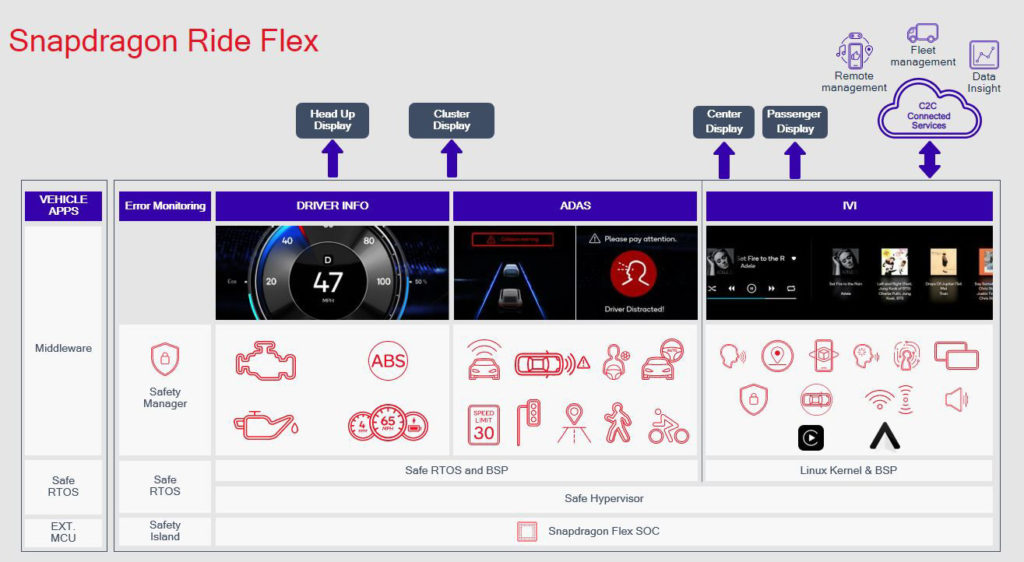Highlights:
-
Snapdragon Ride Flex SoC (System-on-Chip) product family is built on Qualcomm Technologies’ leadership in Digital Cockpit and Advanced Driver Assistance Systems (ADAS) compute platforms
-
Snapdragon Ride Flex SoC supports mixed-criticality workloads, allowing for digital cockpit, ADAS and automated driving (AD) capabilities to be co-implemented on the same hardware
-
Snapdragon Ride Flex SoC is pre-integrated with the Snapdragon Ride™ Vision stack – hardware and software are co-designed for computer vision, AI, efficient power consumption for optimal performance in a mixed criticality environment
-
Designed to assist automakers and Tier-1 suppliers to realize a unified central-compute and software defined vehicle architecture, Snapdragon Ride Flex SoC offers performance scalability ranging from entry to super compute tiers
-
The first Snapdragon Ride Flex SoC is sampling now for an expected start of production beginning in 2024
Jan 4, 2023 | Las Vegas | Qualcomm Technologies, Inc. today announced the latest addition to the company’s growing Snapdragon® Digital Chassis™ product portfolio with the introduction of the Snapdragon Ride™ Flex SoC. The Flex SoC is engineered to support mixed-criticality workloads across heterogenous compute resources, allowing for the digital cockpit, ADAS and AD functions to co-exist on a single SoC. Designed to meet the highest level of automotive safety, the Flex SoC enables a hardware architecture to support isolation, freedom from interference, and quality-of-service (QoS) for specific ADAS functions and comes equipped with a dedicated Automotive Safety Integrity Level D (ASIL-D) safety island. Furthermore, the Flex SoC pre-integrates a software platform that supports multi-operating system operating concurrently, hypervisor enablement with isolated virtual machines, and real-time operating system (OS) with an Automotive Open System Architecture (AUTOSAR) to meet the mixed criticality workload requirements for driver assistance safety systems, digital reconfigurable clusters, infotainment systems, driver monitoring systems (DMS), and park-assist systems.
The Flex SoC is pre-integrated with the industry-proven Snapdragon Ride Vision stack, which enables highly scalable and safe driver assistance and automated driving experiences using a front camera to meet regulatory requirements, and multi-modal sensors (multiple cameras, radars, lidars and maps) for enhanced perception that creates an environmental model around the vehicle feeding into vehicle control algorithms. The Snapdragon Ride Vision stack meets the New Car Assessment Program (NCAP) requirements and Europe’s General Safety Regulations (GSR) while scaling up to higher levels of autonomy.
Built on the company’s continued success in developing open, scalable, high-performance, and power-efficient automotive solutions, the Flex SoC family is compatible with the broader portfolio of SoCs within the Snapdragon Digital Chassis Platform. The Flex SoC is optimized for performance scalability, ranging from entry-level to premium, high-end central-compute systems, providing the flexibility to automakers to choose the appropriate performance point for their vehicle tiers. With this capability, automakers are able to realize complex cockpit use-cases, such as integrated instrument clusters with immersive high-end graphics, infotainment and gaming displays, and rear seat entertainment screens, concurrently with latency-critical premium audio experience and the pre-integrated Snapdragon Ride Vision stack. These performance requirements can be realized by utilizing hardware and software co-design.
The Flex SoC is also designed to be an ideal in-vehicle central-compute platform to power the next-generation Software Defined Vehicle (SDV) solutions by providing best-in-class high performance, heterogenous safe compute with the ability to execute flexible mixed critical cloud-native workloads. The in-vehicle compute is complemented by a rich offering of platform software capable of being deployed on a containerized infrastructure. The Flex SoC is supported by a cloud-native automotive software development workflow which includes support for virtual platform simulation that can be integrated as part of in-cloud development operations (DevOps) and machine learning operations (MLOps) infrastructure.
The first Snapdragon Ride Flex SoC is sampling now for an expected start of production beginning in 2024.
“We continue to remain at the forefront of automotive compute innovation, and as we enter the era of Software Defined Vehicles, the Snapdragon Ride Flex SoC family defines a new setpoint for high-performance power-optimized mixed-criticality architectures,” said Nakul Duggal, senior vice president and GM, automotive, Qualcomm Technologies, Inc. “We are making it easier and more cost effective for automakers and Tier-1s to embrace the transition to an integrated, open, and scalable architecture across all vehicle tiers with our pre-integrated suite of hardware, software, and ADAS/AD stack solutions while enabling the ecosystem to differentiate on our platforms with an accelerated time-to-market advantage.”
Qualcomm Technologies’ integrated automotive platforms – inclusive of Snapdragon® Cockpit Platforms, Snapdragon® Auto Connectivity Platforms and Snapdragon Ride Platforms – continue to drive leadership and growth with an order pipeline of more than $30 billion1. As the technology provider of choice for the global automotive industry, we are working alongside automakers utilizing a broad portfolio of automotive solutions with the Snapdragon Digital Chassis.
About Qualcomm
Qualcomm is enabling a world where everyone and everything can be intelligently connected. Our one technology roadmap allows us to efficiently scale the technologies that launched the mobile revolution – including advanced connectivity, high-performance, low-power compute, on-device intelligence and more – to the next generation of connected smart devices across industries. Innovations from Qualcomm and our family of Snapdragon platforms will help enable cloud-edge convergence, transform industries, accelerate the digital economy, and revolutionize how we experience the world, for the greater good.
1As of November 2, 2022. The design win pipeline reflects the current estimated future size of awarded automaker programs, based on forecasts provided directly by automakers and Tier-1 suppliers.


